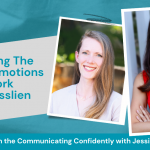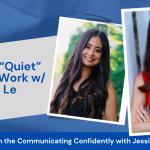Show Up And Speak Up Confidently
Finding the right words to say in front of others can be one of the most frustrating mind games. We can be sitting in a meeting quietly processing what’s happening, but the other side of our mind is telling us loudly that we have to say something.
For those of us who are more “quiet” we know these two distinct voices well – it’s the voice that taunts us to say something before someone else says what we’re thinking, and it’s the voice that douses our confidence because we over-analyze the situation. The result is us staying silent, or we end up saying something but mumbling our words.
 Our CEO and Founder, Jessica Chen, recently hosted a Soulcast Media | LIVE event on LinkedIn, where she interviewed the Founder & CEO of Careercake and Career Coach, Aimee Bateman.
Our CEO and Founder, Jessica Chen, recently hosted a Soulcast Media | LIVE event on LinkedIn, where she interviewed the Founder & CEO of Careercake and Career Coach, Aimee Bateman.
They shared tips and personal stories about how to contribute in meetings and talk about our work, showcase our expertise or advocate for ourselves when others are around.
Our execution can be broken down into the 4A Framework, which is active listening, acknowledging, anchoring, and answering. This sequence gives us the exact rules and cues to look for to gauge when is the right time to speak up so our words have maximum impact. Here’s how it works:
1. Active Listening | Gauge Timing
Active listening is the ability to gauge when is the right time to chime in, especially when there are multiple conversations happening. We need to listen with the intent to speak. This switch is critical because it tells our brain to listen for keywords so we know when to chime in.
For example, if the conversation has moved from talking about operations to now talking about compliance, and we sit in compliance, then now is the time to lean into the conversation to showcase our expertise.
Or, if the team is talking about data and we sit in the data team, then now is the moment to laser in on what people are saying. With timing defined, we then move into inserting ourselves into the conversation by strategically acknowledging the person who spoke right before us.
2. Acknowledge | Create Seamlessness
Once we’ve identified the right moment to speak up, the first few words out of our mouth should be to acknowledge what was just said. Acknowledging is a communication tactic that creates a seamlessness in conversational flow and creates the impression we’re there to collaborate. Because if we jump into a conversation with phrases like, Can I say something or No, I don’t agree, it can feel abrupt or even abrasive.
Acknowledging is how we can create a harmonious environment where people feel heard, and are therefore more receptive to what we have to say. Here are examples of effective acknowledgements:
- That’s a really good point, Joyce, in fact…
- And if I may add to that, Carter, …
By acknowledging the person right before us, including saying their name, we take our listening skills and act upon it. To be clear, acknowledging isn’t agreeing, it’s just showing we’re listening.
Once we’ve acknowledged the person right before us, we will have gained the ears of those in the meeting. The next step is to anchor.
3. Anchor | Connecting Points
Anchoring is where we’ll repeat one or two words the previous person just mentioned to maintain fluidity in the conversation. Anchoring is how we can connect what someone just said to what we want to say. Fluidity is what’ll get others to think we are a very smooth speaker.
- John: The financials here don’t look promising, so I think we need to go an entirely different direction.
- You: It’s a good point you bring up, John, the financials here
- Carter: The client thought the interface of our main page was hard to navigate…
- You: I hear what you’re saying, Carter, and I agree the interface can be improved, which we can consider…
Anchoring is a powerful technique because it challenges us to connect the dots between what someone said to what we have to contribute. It also reduces our urge to use filler words like “um” or “ah” because we are intentional with how we chime in. With all eyes and ears on us, next, it’s time to be pointed with our answer.
4. Answer | Showcase Expertise
Everything we’ve discussed so far in the 4A Framework can be executed in a matter of seconds. While quick, the impact is great because we now have primed the people in the meeting to listen. Now, we’ll want to make our compelling point, suggestion, or pitch to showcase our expertise. However, I’d be remiss if I didn’t say this is where most people flub their opportunity to make a compelling point.
Because with all eyes on us, many people may get flustered and lose their train of thought. Or, they may start mumbling words and/or talking very fast. We’ve all seen it happen.
So, how can we make sure we share our thoughts with clarity and conviction? We must ask ourselves what I call the golden question of communications: What’s the point I’m trying to make here? It’s a question so simple yet so powerful. On TV, it’s a question journalists use every day when formulating their message to sharpen their speaking.
Being seen, heard, and valued can truly work wonders in our lives. But here’s the thing, no one’s going to hand us a permission slip to speak up. It’s up to us to seize those opportunities and make our voices heard.
Check out Jessica’s Youtube Channel to see the full LIVE version of Jessica and Aimee’s conversation.
__
Whenever you’re ready, there are 3 ways we can help you:
- Discover your communications style so you know where to start. Over 4,000 people have found theirs here.
- Attend our monthly communication workshop to build communications confidence (new topics: public speaking, advocating for yourself, building credibility, etc) here.
- Get your brand in front of 43k+ people by sponsoring our newsletter or Soulcast Media | LIVE LinkedIn events [contact: hello@soulcastmedia.com]











